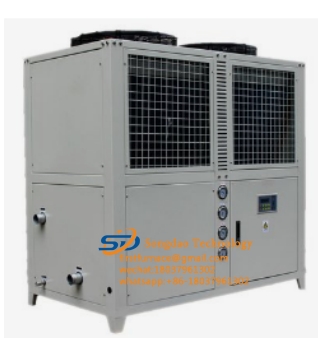- 04
- Nov
The structure and analysis of chiller
The structure and analysis of குளிர்விப்பான்
First of all, the components of the chiller, the compressor is the core component of the chiller, and the kinetic energy provided by the compressor enables the chiller to continuously circulate.
The compressor is divided into a suction side and a discharge side. The suction side sucks in refrigerant gas and the discharge side discharges refrigerant gas. In the working chamber of the compressor, the compressor compresses the refrigerant gas sucked in through the suction side, and then the refrigerant gas It will become a high-temperature and high-pressure refrigerant gas, which is then discharged through the exhaust end.
After the exhaust end is an oil separator, whose purpose and function is to separate the frozen lubricating oil contained in the refrigerant, and then the condenser. The pure refrigerant after oil separation enters the condenser pipeline. According to different chillers, they are divided into two categories: air-cooled and water-cooled. The heat dissipation and temperature reduction method of air-cooled condensers is different from that of water-cooled condensers, but they all exist for condensing.

Whether it is air-cooled or water-cooled, the temperature of the condenser is often very high during the working process and during the condensation process, because the condenser is a heat exchanger, which is used to exchange heat, and the heat is forced to flow through the air or through the cooling cycle The water is taken away to cool down the refrigerant.
After the condensing process, the refrigerant becomes a low-temperature and high-pressure liquid. The throttling and pressure reduction is required below. The throttling and pressure reduction device is an expansion valve for most chillers. To be precise, it is Thermal expansion valve.
The thermal expansion valve can judge the size of the opening and closing opening according to the temperature sensor at one end of the evaporator of the chiller, and then let the refrigerant liquid of the appropriate flow size enter the evaporator process, and reduce the pressure when passing through the thermal expansion valve, that is, Throttling and depressurization.
The liquid refrigerant will then pass through the evaporator, evaporate and absorb heat to achieve refrigeration, and then travel in a liquid state to return to the compressor (and also pass through a gas-liquid separator).
